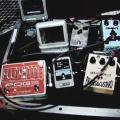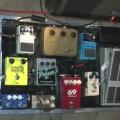 So this started with a very innocent visit to a local amp builder here. I was armed with a pedal board and my Jazzmaster and was going to give a quick test drive on a couple of amps, but during that conversation, they mentioned that they’re researching FCC compliance for their products. What? Never heard of this, but then again, I don’t build amps, but what really threw me for a loop, is that they mentioned Electro-Harmonix (New Sensor Corporation) was fined $450,000 for not being in compliance! Whoa! Now, that’s major. Here is what’s the kicker, it was because of a few pedals. Basically, in a nutshell, it’s about frequencies (specifically anything over 9kHz). If you have a electronic device/components.. including ICs, etc that creates a frequency of 9kHz or greater needs to be tested for emissions.
So this started with a very innocent visit to a local amp builder here. I was armed with a pedal board and my Jazzmaster and was going to give a quick test drive on a couple of amps, but during that conversation, they mentioned that they’re researching FCC compliance for their products. What? Never heard of this, but then again, I don’t build amps, but what really threw me for a loop, is that they mentioned Electro-Harmonix (New Sensor Corporation) was fined $450,000 for not being in compliance! Whoa! Now, that’s major. Here is what’s the kicker, it was because of a few pedals. Basically, in a nutshell, it’s about frequencies (specifically anything over 9kHz). If you have a electronic device/components.. including ICs, etc that creates a frequency of 9kHz or greater needs to be tested for emissions.
I wanted to post this in case some of you boutique, small time builders are unaware of this. Obviously EHX didn’t know.. and they’re huge, and they got slapped hard. Of course, getting tested is expensive, in this is a major PIA, but it’s good to be aware.
Electro-Harmonix posted a Compliance Practice Guide for Manufacturers (in PDF format), but I included the content here as well for a quick read. The compliance practice guide was originally posted June 24, 2013.
Please let me know what you think about this by commenting below.
INTRODUCTION
One of the great things about M.I. is that it still provides opportunities for creative entrepreneurs to bring to market new products that satisfy their belief of what a really cool effect pedal, guitar amp or electronic musical instrument should be. A quick flip through a guitar magazine will reveal that a flourishing cottage industry of “boutique†makers is in full bloom!
But what you don’t know, can come back to bite you! So, as a major supplier of vacuum tubes, cases and components for these grass roots capitalists, we felt compelled to shed some daylight on a subject that can’t be ignored. The following article describes the dos and don’ts of complying with the FCC’s regulations that affect all makers of digital devices for use in the music industry. And guess what? Even though you may think the device you make is analog, not digital, you might be incorrect according to the FCC’s interpretation of what is and what is not digital! So read on…
Please Note: This Compliance Practices Guide is not an FCC publication, nor is reviewing it a substitute for a careful and independent assessment of the FCC’s equipment marketing rules. Rather, the Guide provides a useful starting point for companies in the digital music industry as they work to ensure compliance with applicable FCC’s rules.
WHAT ARE EQUIPMENT MARKETING RULES?
The Equipment Marketing Rules are the set of laws and rules, as laid out by the Federal government and enforced by the FCC, to govern the “marketing of radio frequency devices within the United States and its territories.†Marketing, as defined by Code of Federal Regulations (C.F.R.) Title 47, Volume I, Chapter I, §2.803, includes the sale or lease, or offer to sell or lease your musical instrument product, including advertising in any form. Marketing also includes importing, shipping or distributing a product for the purpose of selling or leasing. A quick bullet point list of the equipment marketing rules includes:
ï‚· product compliance for radiated and conducted emissions
ï‚· proper labeling of the product
 proper statement inclusion in the product’s manual
ï‚· correct import procedureARE THE EQUIPMENT MARKETING RULES OPTIONAL SUGGESTIONS?
The rules and laws that we go over during the course of this article are not optional for any manufacturer, they are requirements. You cannot sell or market a product unless it fully complies with the FCC’s rules. We will go over the important rules that apply directly to manufacturers of digital musical instruments. Of course, these rules may also apply to other industries, in particular those
industries that manufacture electronic devices for consumers or the general public. Electronic devices made exclusively for industry or U.S. government have a different set of rules to abide by that is beyond the scope of this guide.
WHAT IS CONSIDERED A DIGITAL DEVICE?
Within the scope of radio frequency devices is a sub-class known as Class B digital devices. The majority of digital musical instrument products fall into this category. A digital device is defined as “an unintentional radiator (device or system) that generates and uses timing signals or pulses at a rate in excess of 9,000 pulses (cycles) per second and uses digital techniques.†A Class B digital device is defined “as a digital device that is marketed for use in a residential environment notwithstanding use in commercial, business and industrial environments.†Both definitions are found in 47 C.F.R., §15.3.
The phrase “and uses digital techniques†is a little arbitrary so the safest approach a manufacturer can take is to figure out if their device generates signals or clocks above 9kHz (9000 cycles per second) and if it does, ensure the device is fully compliant with the Equipment Marketing Rules. There are numerous types of circuits and ICs out there that fall into this category; some common examples that are often used in musical instruments include DSPs, A/D and D/A converters, micro-controllers, switching power supplies (such as charge pumps or buck regulators), VCOs, PWM control signals and switched capacitor filters. Any one of these types of circuits could easily run above 9kHz, some generate at least one signal that is above 1MHz.
An IC does not necessarily have to output a high frequency signal to be considered a digital device. Even if the IC contains all high frequency signals within the chip and the signals do not connect to a component outside the IC, the product should be considered a digital device.
There are cases where a musical instrument uses digital logic but the instrument does not generate any signals above 9kHz. These types of circuits would not be considered digital devices according to the Equipment Marketing Rules. One example found in numerous musical instrument circuits uses the CD4066 IC to switch an analog signal path when the musician presses a button. Although digital logic is used to switch the signal path, the frequency of the pulses is far below 9kHz and therefore it is not considered a digital device. Another circuit found in many musical instruments is a low frequency oscillator (LFO) waveform generator. We usually see these circuits in modulation type effects such as tremolos, filters and phase shifters. Normally these circuits do not generate waveforms above 100Hz and it’s even rarer for them to generate signals above 1kHz. These circuits would not cause a product to fall into the digital devices category.
Taking the Electro-Harmonix (EHX) brand as an example, the Big Muff π distortion pedal is not considered a Class B digital device because it does not generate any signals above 9kHz nor does it use any digital techniques, though it can process signals in excess of 9kHz that are present at its input.
The EHX Small Clone analog chorus pedal on the other hand is considered to be a Class B digital device. It uses a logic IC to output a digital clock signal ranging from 20kHz to 80kHz. The Small Clone exceeds the digital device minimum of 9kHz by close to a factor of 10. The clock signal drives the bucket brigade IC which creates a time delay for the audio signal. The Small Clone also contains an LFO circuit, as mentioned above, but the LFO circuit does not qualify it as a digital device. EHX would normally consider the Small Clone to be an analog product, and in fact it is called an analog chorus in its promotional literature, but according to the Equipment Marketing Rules, it is a digital device and must comply fully with the rules in order to be sold and marketed in the United States.
ARE THERE EXEMPTIONS FOR ANY DIGITAL DEVICES?
There are a number of circumstances where a digital device may be exempt from the FCC’s technical standards. Most exemptions are outside the realm of musical instruments though there are a couple cases that could be a nice fit for musical products:
If your instrument does not obtain power from a wall outlet’s AC power lines, either directly or through an AC Adapter/battery eliminator and it does not generate or use any frequencies above 1.705 MHz, then the product may be exempt.
If a digital musical instrument is extremely low power it may be exempt as well. The device’s power consumption cannot exceed 6nW.
Although the products may be exempt from technical standards, there may be other requirements to which the digital device needs to adhere. For more information on exemptions, please see 47 C.F.R., §15.103.
TESTING YOUR DIGITAL MUSCIAL INSTRUMENT FOR RADIATED AND CONDUCTED EMISSIONS
One of the trickiest hurdles for any engineering group when designing a digital musical instrument is ensuring that your product complies with the FCC’s rules on radiated and conducted emissions. Testing a product for its FCC emissions compliance is an additional step in the product’s development that must be included during the course of its design cycle and planning. The earlier you plan ahead to reduce RF emissions in your design, the easier it will be to pass emissions testing once you have a production sample ready to test. For some products, especially those that contain high frequency components running above 1MHz, it could be nearly impossible to pass emissions testing if the product was not designed from the beginning to do so.
There are two basic classifications of digital devices or RF radiators: products that are not meant to communicate wirelessly with other devices are known as Unintentional Radiators (for example most guitar pedals, synthesizers, amplifiers); products that do feature wireless communication are called Intentional Radiators (for example wireless mics, wireless guitar systems). Class B digital devices are considered Unintentional Radiators.
Your digital musical instrument must have FCC authorization before you can market it in the United States. According to 47 C.F.R., §15.101, there are three levels of equipment authorization for unintentional radiators: Certification, Declaration of Conformity and Verification. Unless your musical instrument houses a personal computer, pretty much all digital musical instruments, since they are Class B digital devices, require verification. The definition of verification is as follows from 47 C.F.R., §2.902:
Verification is a procedure where the manufacturer makes measurements or takes necessary steps to insure that the equipment complies with the appropriate technical standards. Submittal of a sample unit or representative data to the Commission demonstrating compliance is not required unless specifically requested by the Commission…
Verification covers all items that are identical to the sample tested and found acceptable by the manufacturer.
Based on the Verification definition it is within the rights of the musical instrument manufacturer to self-certify their products, to build a testing facility in their factory and to conduct all compliance tests in-house. Of course this could be a major undertaking; most manufacturers may want to instead send their sample units to testing houses who will conduct the tests for them. There are numerous accredited testing facilities around the country; three examples include Nemko-CCL, Retlif Testing Laboratories and TUV Rheinland.
The FCC spells out the radiated emission limits in section §15.33. As a rule of thumb, the testing range for radiated emissions usually covers 30 MHz to 1GHz. If your product generates frequencies between 108MHz and 500MHz, the upper testing limit increases to 2GHz. If your product generates frequencies between 500MHz and 1GHz, then your testing range will be expanded to 5GHz. For conducted emissions, the testing range is 150kHz to 30MHz.
In general it is more difficult to pass the radiated emissions testing than it is the conducted testing. If your product passes radiated testing, it will almost definitely pass the conducted test. You may want to concentrate more of your resources on making sure your device passes the radiated testing.
When your product passes its compliance testing, the testing facility will produce an official test report for you. If the FCC asks your company for equipment authorization documentation at any point, the official test report will be the most important document that you hand over to them. Keep the official report on file during the lifetime of the product plus up to two years after a product ceases shipments to retailers or consumers.
NOW THAT YOUR INSTRUMENT HAS FCC AUTHORIZATION, INFORM THE USER
For all digital devices sold within the United States, the Equipment Marketing Rules dictate that certain labels and statements must be included both on the device itself and within its user manual. The purpose of the labeling and text is to inform the musician that the instrument has been tested and found to comply with the FCC’s standards.
DEVICE LABELLING
The FCC requires the musical instrument to be labeled somewhere on the unit with the following statement from 47 C.F.R., §15.19, paragraph 3:
This device complies with part 15 of the FCC Rules. Operation is subject to the following two conditions: (1) This device may not cause harmful interference, and (2) this device must accept any interference received, including interference that may cause undesired operation.
In addition to the above statement, each verified product must be uniquely identifiable. This means that the product must have a model name, model number or artwork printed on the unit that will identify it and separate it from other products. Most musical instrument manufacturers have no trouble with this requirement.
If the product is too small to allow all the required text, the manufacturer may leave the text off the product and instead insert the required statement into a prominent location in the user manual or on the carton in which the product is sold. (See 47 C.F.R., §15.19, paragraph 5 for more detailed
information).
USER MANUAL TEXT
In addition to labeling the product, the FCC also requires the statement below, or a similar statement, to be located in a prominent location in the user manual. Please note: this text is in addition to the text that is required to be on the product itself. From section 47 C.F.R., §15.105:
Note: This equipment has been tested and found to comply with the limits for a Class B digital device, pursuant to part 15 of the FCC Rules. These limits are designed to provide reasonable protection against harmful interference in a residential installation. This equipment generates, uses and can radiate radio frequency energy and, if not installed and used in accordance with the instructions, may cause harmful interference to radio communications. However, there is no guarantee that interference will not occur in a particular installation. If this equipment does cause harmful interference to radio or television reception, which can be determined by turning the equipment off and on, the user is encouraged to try to correct the interference by one or more of the following measures:
— Reorient or relocate the receiving antenna.
— Increase the separation between the equipment and receiver.
— Connect the equipment into an outlet on a circuit different from that to which the receiver is connected.
— Consult the dealer or an experienced radio/TV technician for help.IMPORTING YOUR DIGITAL MUSCIAL INSTRUMENT INTO THE UNITED STATES
If you import your musical instrument into the United States, whether it’s the entire product or just the portion of the product that contains the RF device, such as an assembled PCB with a DSP installed on it, the FCC spells out certain rules to be followed and requires a declaration at the time of importation. Filing FCC Form 740 with U.S. Customs and Border Protection (CBP) is the heart of the importation procedure but it is also important to know what you can and cannot import.
WHAT CAN BE IMPORTED
Before you can import production quantities of your digital musical instrument to be offered for sale, it will need to have its equipment authorization in order. As mentioned earlier in this article your authorization will either be Verification, Certification or a Declaration of Conformity. In the case of verification, declaring to the CBP that the imported device complies with the FCC’s technical requirement is usually all that is required.
It is very likely that you will need to import samples of the product before importing larger production quantities. The samples are not only used to test the abilities of the PCB assembly house or to test the design itself for its intended purpose but also allow you to test the product for FCC emissions compliance. The FCC allows for the importation of up to 4000 units for these purposes as long as the units “will not be offered for sale or marketed.†See 47 C.F.R., §2.1204 for further information on the import conditions.
FILING FORM 740: DECLARING YOUR DIGITAL MUSICAL INSTRUMENT
FCC Form 740 is a statement of declaration for importing radio frequency devices. It must be filled out and filed with the CBP at the time of importation for any digital device or even a device’s assembled PCB. A PDF copy of Form 740 can easily be found through a web search.
Form 740 has two parts: Part I requires information specific to your company: the manufacturer, the product and so on. Part II is your declaration for the device, asking you to choose one declaration. In most cases, digital musical instruments require verification and do not require FCC certification or declaration of conformity. If your product requires verification then you will want to choose box number 2 which states:
An FCC grant of equipment authorization and an FCC ID are not required, but the equipment complies with FCC technical requirements
If you are importing samples for testing purposes or to show at a trade show, then you would choose either box 3 or 4. In the rare case that you are importing products solely to be exported you would choose box 5.
ENFORCEMENT BY THE FCC OF THE EQUIPMENT MARKETING RULES
It is up to the manufacturers and designers of musical instrument products that contain potential RF emitting digital circuits to follow the FCC’s rules and regulations just like it is up to the driver of a car to obey the speed limit. The FCC’s job is to enforce their rules.
We do not know all of the inner workings of how the FCC chooses to check a company for full compliance across their product line. If your company is chosen, you will most likely be asked, via a letter, to submit proof that your product line complies with the FCC’s rules and regulations. If you have been adhering closely to their rules then you have nothing to worry about. Simply submit the documentation the FCC asks for and it should satisfy their inquiry. For typical cases, the documentation will include official test reports showing the digital devices comply with both radiated and conducted emissions, the user manuals which include the FCC statement(s) and proof that the products are labeled appropriately.
If the FCC finds that products you manufacture or import are in some way in violation of their rules they will usually come up with a fine based on the number of products that are in violation and the number of violations per product. Of course each situation is different and this guide cannot do more than warn you that the FCC does enforce their rules and will fine you if it finds violations. It is up to your company to ensure that your products are fully compliant.
CONCLUSIONS
From the start of your digital musical instrument’s design cycle to its launch on your website and of course throughout its lifetime as a manufactured product it is of the utmost importance to follow and adhere to the FCC’s Equipment Marketing Rules. If your company adopts the FCC rules early on and makes them part of the normal operating procedure, they become second nature, essentially part of your design DNA. It might be a good idea to assign a compliance officer whose job it is to make sure the products pass FCC emissions testing, the products are labeled correctly, the user manual includes the appropriate statement(s) and last but not least the importation declaration is properly filed. For further reading and research, a good place to start is the FCC’s Office of Engineering and Technology (OET) website found at the following URL: http://transition.fcc.gov/oet/ea/Welcome.html.




